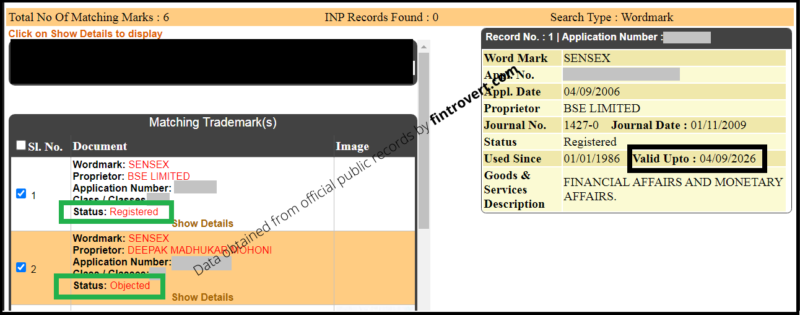SENSEX (= SENSitive + indEX) is an index calculated from the stock prices and free-float market capitalization of the top 30 companies under the Bombay Stock Exchange (BSE).
[Also Check: Basics of Stock Market Investing in USA: Explained in a Fun Way!!]
( Read this blog in Hindi here | इस ब्लॉग को हिंदी में यहाँ पढ़ें : https://fintrovert.com/blogs/सेंसेक्स-क्या-होता-है/ )
What is there in the name and who exactly owns it !!

Mr. Deepak Mohoni’s twitter handle
Before going into the details of calculations, let us see how the term originated and the interesting conflict around it.
The word ‘Sensex’ was coined by Mr. Deepak Mohoni in 1989 as a short merged term for BSE ‘Sensitive Index’. Interestingly, though BSE officially uses the term, there had been a trademark conflict between Mr. Deepak and BSE during 2008. A point to note that Mr. Deepak had just coined the short term ‘Sensex’ in 1989. ‘BSE Sensitive Index’, introduced by the Bombay Stock Exchange, was calculated and was in usage since 1986.
After further exploration of official trademark records, the Fintrovert team has found that BSE Limited has registered and still holds the trademark for ‘SENSEX’ till 04/09/2026 and is objected by Mr. Deepak Mohoni.
Currently, it is officially called ‘S&P BSE SENSEX’, which stands for ‘Standard and Poor Bombay Stock Exchange Sensitive Index’.
In February 2013, S&P Dow Jones Indices (by S&P Inc., a publicly-traded American corporation) and the BSE partnered to calculate the widely followed BSE indices, one of which is S&P BSE SENSEX, also called as SENSEX in daily usage.
SENSEX Inclusion
For inclusion in Sensex, companies are shortlisted and ranked based on their average six-month float-adjusted market capitalization and average six-month total market capitalization. Though various other eligibility criteria are applied for the basic filtering of stocks, free-float market capitalization plays a major role in the calculation of Sensex as we will see further.
Companies are initially selected for Sensex inclusion irrespective of sector. If the target constituent count of 30 is not achieved, then non-constituent companies ranked 22 to 30 are included by giving preference to those companies whose sector is underrepresented.
SENSEX Calculation
Sensex = (Total Free-Float Market Capitalization of 30 Companies / Base Market Capitalization in 1978-79) x (Base Index Value)
where,
Free-float market capitalization of a company = (Total no. of shares of the company readily available for trading in the market (excluding Government’s, Promoters’ holdings, etc.)) x (Current stock price of the company)
Base Market Capitalization = Free-float market capitalization of companies under consideration in 1978-79 as it is considered to be the base year for calculation
Base Index Value = 100 (Fixed. As decided by the Index Committee to indicate 1978-79’s index value)
Example:
Suppose Index consists of only 4 companies named A, B, C and D with the following details:
Company A B C D
Total no. of shares in Market 100 500 300 100
Shares with Government 10 100 20 20
Shares in Promoters’ Holdings 20 50 100 30
Free-float Market Shares
= Total Shares - (Government Shares + Promoters’ Shares)70
= 100 -
(10 +20)350 180 50
Current Share Price 200 5 60 300
Free-float Market Capitalization
= Free-float Market Shares x Current Share Price
14,000
= 70 x 200
1,750 10,800 15,000
Suppose that the free-float market capitalization of these 4 companies in the base year 1979 was 250.
Consider base index value is 100 as in actual Sensex calculations.
Here current total free-float market capitalization comes out to be 14,000 + 1,750 + 10,800 + 15,000 = 41,550.
So as per formula Sensex = (41550/250) x 100 = 16,620
Note: These examples are considered for ease of calculation and understanding. In actual Sensex calculations, there are more (30) companies, and some additional adjustments are also done considering regular mergers, dividends, etc.
SENSEX Maintenance and Rebalancing
Sensex rebalancing is done semi-annually in June and December on Monday following the third Friday. Reference dates are the last trading days of April and October respectively.
Sensex is also adjusted on an ongoing basis to account for delistings, takeovers, mergers, suspensions, bankruptcies, dividends, etc.
[Terms Related to Sensex one should know: BSE Sensex, Sensex Today, Sansax, Sensax (often misspells of Sensex), Nifty, Nifty Today, Nifty Share Price, Bank Nifty, Sgx Nifty, BSE Index, Sensex Charts, Nifty Chart, Bank Nifty Chart
To know about such basic terms, check this page: https://fintrovert.com/blogs/basics-of-stock-market-imp-terms-and-definitions/ ]
SENSEX Levels over the years
SENSEX Constituents
Current 30 constituent Companies of S&P BSE SENSEX are (as on September 2023):
HDFC Bank, ITC, Tata Consultancy Services, Infosys, Hindustan Unilever, Reliance Industries, ICICI Bank, HDFC, Mahindra & Mahindra, Kotak Mahindra Bank, NTPC, Bajaj Finance, Bharti Airtel, State Bank of India, Wipro, Maruti Suzuki India, Nestle India, Titan Company, Coal India, Asian Paints, Larsen & Toubro, HDFC Life Insurance, Axis Bank, Power Grid Corporation of India, Indian Oil Corporation, Dr. Reddy’s Laboratories, Tech Mahindra, UltraTech Cement, Sun Pharma, HCL Technologies, Bharat Petroleum Corporation, Tata Steel



